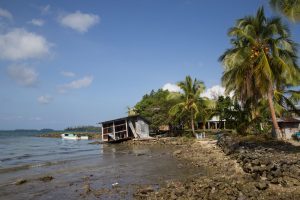As Aussies, we can get pretty riled up at the prospect of the destruction of public monuments, historic sites and places we consider important to the fabric of our national culture and identity.
Take the Sydney Opera House. We all love it. And there was uproar when those sacred sails were going to be cheapened as a mere billboard for a horse race. We also revere landmarks on the other side of the world, equally aghast as flames engulfed Notre Dame cathedral in 2019, as we were devastated when the Taliban destroyed the Buddhas of Bamiyan.
Back at home, the veneration with which Australians approach an annual event such as Anzac Day is obvious. On the other hand, when it comes to 65,000 years of Aboriginal history, many of us are unaware of, or undervalue, the amazing heritage and culture right here in our backyard.
Did you know Australia houses the world’s largest outdoor gallery, home to at least a million rock carvings on Western Australia’s Burrup peninsula? The petroglyphs at Murujuga (which means ‘hip bone sticking out’ in the Ngarluma-Yaburara language) date back some 45,000 years to the last Ice Age. Murujuga is about ten times older than the Pyramids of Giza and Stonehenge.
The carvings show animals that are now extinct, including the Tasmanian Tiger (thylacine), before sea level rise separated Tasmania from the mainland.
Murujuga is so ancient its carvings track the end of the Ice Age. It is possible to see how, as the sea rose, the animals depicted began to include marine life such as turtles. All these petroglyphs are the collective history not only of this continent and the Aboriginal people who lived there for tens of thousands of years, but of Earth itself.
It is currently also the site of a giant fertiliser factory, sitting within a large industrial space.
I don’t accept that we would allow such a site to be used like this if a Catholic church sat upon it, or the Sydney Opera House, for that matter. One of the reasons I will be voting Yes at the upcoming Voice Referendum is because I think it will help all Australians discover and value the whole of this country’s incredible history and heritage, beyond just the last 200 or so years, and we will all be richer for it.
Closing the Gap in life expectancy has been the dominant driving force of the emergence of the proposed First Nations Voice to parliament since 2017. And rightly so – I’ll wait here for a more important reason to have a Constitutionally-enshrined advisory body than ensuring our first peoples live as long as their fellow Australians.
We can rest assured improvements to Indigenous housing, better education outcomes and better-directed funding for infrastructure related to First Nations’ needs will be key focus areas following the establishment of the Voice in the event of a “Yes” result at the upcoming referendum.
During the pandemic, the Australia Institute began a webinar series and as its host I have been fortunate enough to interview a number of Aboriginal leaders fighting for better health and justice outcomes. We partnered with Change the Record—Australia’s only national Aboriginal-led justice coalition of legal, health and family violence prevention experts—which aims to end the over-representation of Aboriginal Australians in the justice system, including deaths in custody, and to get children as young as ten years old out of prison by raising the age of criminal responsibility. We cannot keep doing the same things and expect a different result.
I’ve interviewed health professionals from Aboriginal-controlled community health organisations (ACCHOs), whose response to the pandemic was the ‘best in the world’, according to epidemiologist and former Australian of the Year Professor Fiona Stanley:
“…Within the first 18 to 20 months of the pandemic, Aboriginal people had six times fewer cases than non-Indigenous people did. How did they do it? They had a voice.
“They had a Voice in the National Aboriginal Community Controlled Health Organisation. They had a Voice at all state and territory organisations right down to communities.”
I’ve also interviewed Co-Chairs of the Uluru Dialogue Professor Megan Davis and Pat Anderson AO, co-authors of upcoming book “Our Voices From The Heart: The authorised story of the community campaign that changed Australia” – which revisits all of the regional dialogues held ahead of the Uluru National Convention in 2017.
At the Broome dialogue held in February 2017 and hosted by the Kimberley Land Council, language, culture and connection to land were at the forefront of discussions; in particular, the history of massacres in the region were remembered.
At the session held in Darwin in the Northern Territory, the home of Aboriginal land rights and the beginning of Makarrata: the coming together after a struggle, some delegates saw themselves as “powerful players in a political struggle, carrying the fire of those who had gone before in the Bark Petitions and the claims for land rights”.
In Perth, many dialogue participants stated the impact of First Nations not having a political Voice results in an inability to protect culture and stop the destruction of sacred sites. Hopefully, over time, the Voice will help us all value places like Murujuga as much as we value the Pyramids, Stonehenge and the Sydney Opera House.
To me, having a Voice to Parliament enshrined in Australia’s Constitution will fundamentally strengthen our democracy. The Voice will gift the Parliament with the insight of 65,000 years of Aboriginal and Torres Strait Islander culture, heritage and knowledge. We have nothing to lose and everything to gain.
Whether it’s health, heritage or otherwise, it is clear that when Aboriginal people and communities have a Voice, things get better. That’s why I’m voting Yes.
Authorised by Ebony Bennett, The Australia Institute, Level 1 Endeavour House, 1 Franklin St, Manuka ACT 2603.
Between the Lines Newsletter
The biggest stories and the best analysis from the team at the Australia Institute, delivered to your inbox every fortnight.
You might also like
Our crisis of integrity looms in the Pacific
“An Albanese Labor government will restore Australia’s climate leadership, and listen and act on Pacific island warnings of the existential threat of climate change.” Despite a clear election campaign commitment to listen to Pacific Island nations and act on climate change, the Australian government continues to enable and encourage new and expanded fossil fuel projects. When it
Unfinished Business: Towards a settlement on Aboriginal land rights in the ACT
The Australia Institute has today published a discussion paper on the barriers to progress on Aboriginal land rights in the ACT. The paper explores the issues that need to be resolved before the ACT Government can make progress on treaty discussions. Key Findings: The transfer of the land of the ACT from NSW to the
History shows American political violence is nothing new: Thomas Jefferson said ‘the blood of patriots’ is liberty’s ‘natural manure’
If you select “virtually any date in US history, it would be possible to find the same poisonous ingredients [… that] percolated violently to the surface on January 6th, 2021,” writes journalist and historian Nick Bryant in his new book, The Forever War: America’s Unending Conflict with Itself. Over two centuries ago, in 1787, Thomas Jefferson,

